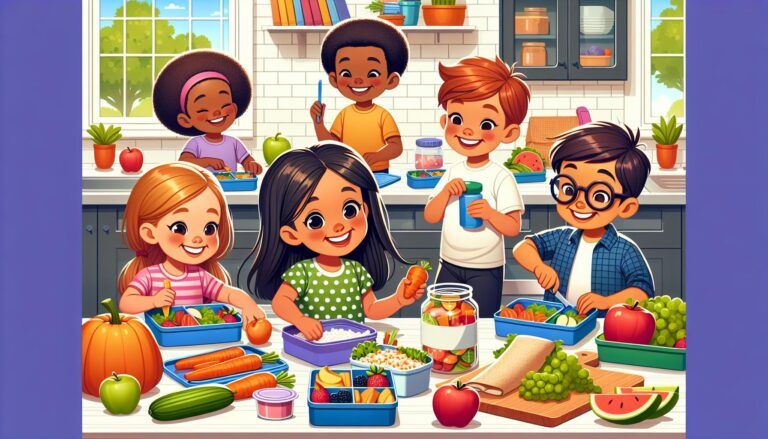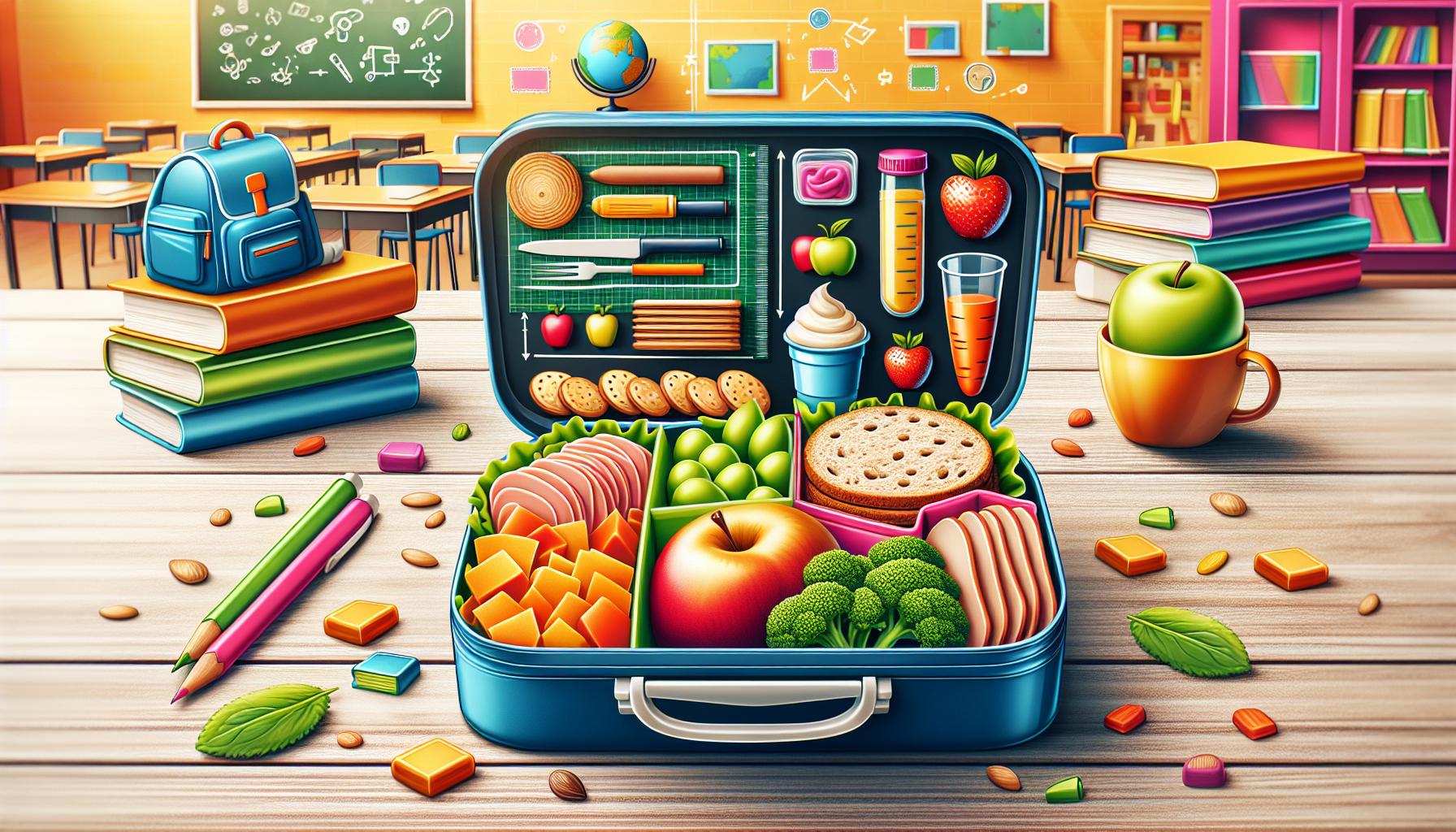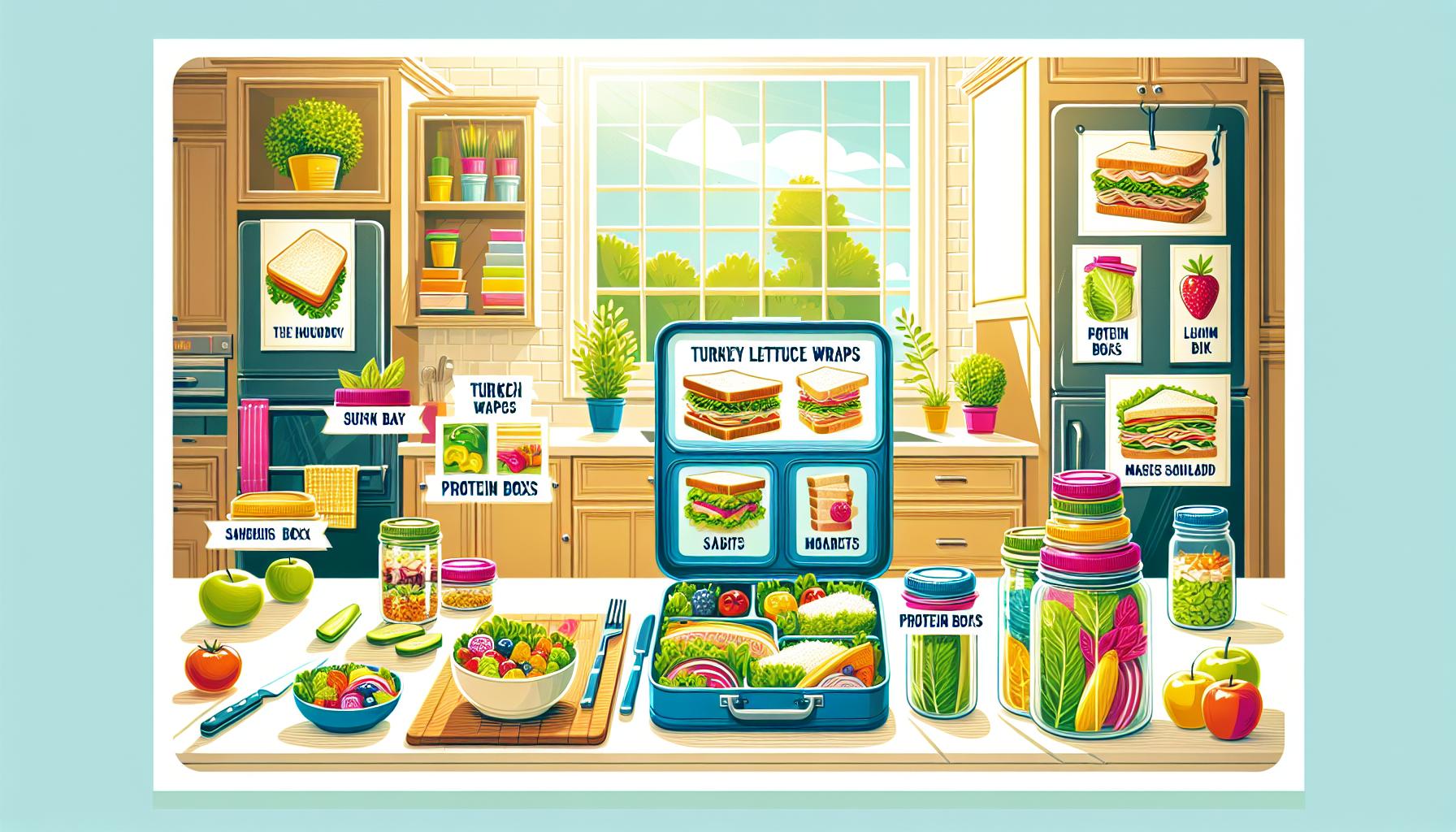
We all know the morning rush of packing school lunches can feel overwhelming. Between getting kids ready and racing out the door on time, finding fresh lunch ideas that your children will actually eat becomes a daily challenge for many parents.
Looking for ways to shake up your kids’ lunchbox routine? We’ve gathered creative and nutritious lunch ideas that’ll make the morning prep easier while keeping your children excited about their midday meal. From make-ahead options to quick assembly combinations, these lunch solutions work for both picky eaters and adventurous palates alike. Let’s explore how we can turn the daily lunch-packing task into a simple and enjoyable experience.
Key Takeaways
- Balanced school lunches significantly impact academic performance, with students showing 15% higher concentration levels when eating nutritious meals compared to processed foods
- Essential components of a healthy school lunch include proteins (2-3 oz), whole grains (1-2 servings), fruits/vegetables (1-2 cups), and healthy snacks (¼-½ cup)
- Weekend meal prep strategies like batch cooking, portioning snacks, and organizing containers can streamline weekday lunch packing and save time for busy parents
- Proper food safety requires maintaining cold foods below 40°F and hot foods above 140°F, with perishable items needing refrigeration within 2 hours
- Cost-effective lunch planning involves buying seasonal produce, purchasing bulk ingredients, and utilizing batch cooking methods to maximize savings
- Involving children in lunch preparation based on age-appropriate tasks helps develop independence and essential life skills while making the process more engaging
Why School Lunches Matter for Academic Success
A balanced school lunch powers children’s academic performance through essential nutrients for brain function. Students who eat nutritious lunches demonstrate 15% higher concentration levels during afternoon classes compared to those who consume processed foods.
Here’s how school lunches impact learning:
- Brain Power: Foods rich in omega-3 fatty acids like tuna sandwiches or walnuts enhance memory retention
- Energy Levels: Complex carbohydrates from whole grain breads maintain steady energy throughout the day
- Focus: Protein-rich foods such as eggs or lean meats improve concentration during lessons
- Mood: Fresh fruits provide natural sugars that stabilize mood swings between classes
| Nutrient | Academic Benefit | Lunch Examples |
|---|---|---|
| Protein | 12% better test scores | Turkey roll-ups |
| Whole Grains | 20% longer attention span | Quinoa bowls |
| Healthy Fats | 10% improved memory | Avocado wraps |
| Vitamins | 18% increased alertness | Fresh fruit cups |
Research from the Journal of School Health indicates children who eat balanced lunches score 17% higher on standardized tests. A properly packed lunch supports:
- Learning Retention: Balanced meals help students remember new information
- Class Participation: Steady blood sugar levels increase active engagement
- Problem Solving: Essential nutrients boost critical thinking abilities
- Physical Activity: Sustained energy supports playground and gym activities
Studies show students with proper nutrition miss 3 fewer school days per year on average. This improved attendance directly correlates with better academic outcomes across all grade levels.
Essential Components of a Balanced School Lunch

A balanced school lunch contains five key nutritional elements that support children’s growth and learning. Here’s how to incorporate these essential components into your child’s lunchbox.
Proteins and Whole Grains
Proteins maintain steady energy levels throughout the school day while whole grains provide lasting fuel for active minds. Pack lean protein options like:
- Turkey or chicken slices (2-3 oz portions)
- Hard-boiled eggs cut in halves
- Greek yogurt cups (4-6 oz serving)
- Tuna salad made with light mayo
- Hummus (4 tablespoon serving)
Pair these with whole grain selections:
- Whole wheat bread or wraps
- Quinoa mixed with vegetables
- Brown rice cakes
- Whole grain crackers (6-8 pieces)
- Oat-based granola bars
Fruits and Vegetables
Fresh produce delivers essential vitamins and minerals that boost immunity and brain function. Include these colorful options:
- Sliced apples with cinnamon
- Baby carrots with ranch dip
- Cherry tomatoes (5-6 pieces)
- Cucumber rounds
- Orange segments
- Mixed berries (½ cup serving)
- Sugar snap peas
- Bell pepper strips
- Trail mix with nuts and dried fruit (¼ cup portion)
- String cheese sticks
- Roasted chickpeas (½ cup serving)
- Popcorn (1 cup serving)
- Whole grain pretzels
- Banana chips
- Seaweed snacks
- Plain yogurt cups with honey
| Meal Component | Recommended Portion | Benefits |
|---|---|---|
| Protein | 2-3 oz | Sustained energy |
| Whole Grains | 1-2 servings | Brain fuel |
| Fruits/Vegetables | 1-2 cups total | Vitamins & minerals |
| Healthy Snacks | ¼-½ cup | Blood sugar balance |
Quick and Easy Lunch Box Ideas

Preparing school lunches becomes effortless with these time-saving options that take 15 minutes or less to assemble. These convenient lunch ideas combine nutrition with simplicity for stress-free mornings.
Sandwich-Free Options
Sandwich-free lunches add variety to traditional packed meals while meeting nutritional needs. Here are protein-rich alternatives that stay fresh until lunchtime:
- Roll sliced turkey breast with cheese in lettuce wraps
- Pack protein boxes with hard-boiled eggs, cheese cubes, nuts
- Create mason jar salads with quinoa, chickpeas, vegetables
- Combine Greek yogurt parfaits with granola, fresh berries
- Assemble rice paper rolls with vegetables, shredded chicken
- Mix tuna salad with crackers, cucumber slices
- Layer hummus dip with pita triangles, carrot sticks
Hot Lunch Alternatives
Insulated containers keep these warm lunch options at safe temperatures for 4-6 hours:
- Fill thermoses with:
- Homemade soup (chicken noodle, vegetable)
- Pasta with marinara sauce
- Mac and cheese
- Rice and beans
- Meatballs in sauce
- Pack hot sides in separate containers:
- Roasted vegetables
- Sweet potato wedges
- Grilled chicken strips
- Steamed dumplings
- Baked tofu cubes
| Container Type | Temperature Retention | Best For |
|---|---|---|
| Standard Thermos | 4-6 hours | Soups, pasta |
| Wide-mouth Container | 3-5 hours | Solid foods |
| Bento-style Box | 2-3 hours | Mixed meals |
Each option includes complete protein sources paired with whole grains or vegetables for sustained energy throughout the school day.
Meal Prep Tips for Busy Parents
Effective meal prep strategies transform chaotic mornings into smooth routines. These time-saving methods create organized school lunch assembly while maintaining food freshness throughout the week.
Weekend Prep Strategies
Smart weekend preparation sets up a successful lunch-packing week. Here’s how to maximize weekend prep time:
- Wash all fruits vegetables in one session
- Cut sturdy vegetables like carrots celery bell peppers into strips
- Portion nuts dried fruits crackers into small containers
- Cook hard-boiled eggs for the week
- Prepare protein options like grilled chicken strips tuna salad
- Mix large batches of trail mix granola
- Slice cheese blocks into sticks or cubes
Storage and Organization
Proper storage extends food freshness maintains quality. These storage practices streamline daily lunch assembly:
- Label clear containers with contents expiration dates
- Store cut produce in airtight containers with paper towels
- Separate wet dry ingredients using silicone cups
- Keep prepped ingredients at eye level in the fridge
- Create a designated lunch-packing station
- Use drawer organizers for preportioned snacks
- Store shelf-stable items in labeled bins
- Place frequently used items in easy-reach zones
| Food Type | Temperature | Storage Duration |
|---|---|---|
| Cut Produce | 34-40°F | 3-5 days |
| Cooked Proteins | 34-40°F | 3-4 days |
| Hard-boiled Eggs | 34-40°F | 7 days |
| Dairy Items | 34-40°F | 5-7 days |
| Dried Snacks | Room temp | 2-3 months |
Food Safety Guidelines for School Lunches
Temperature Control
Proper temperature control prevents harmful bacteria growth in packed lunches. Cold foods stay safe at 40°F (4°C) or below, while hot foods require maintaining temperatures above 140°F (60°C). Pack cold items with ice packs or frozen water bottles, and use insulated containers for hot foods. Place perishable items like dairy products, meats, and cut fruits directly against the cooling elements.
Safe Food Preparation
Following basic food safety practices reduces the risk of foodborne illness:
- Wash hands with soap and warm water for 20 seconds before handling food
- Clean all preparation surfaces with disinfectant
- Use separate cutting boards for raw meats and produce
- Rinse fruits and vegetables thoroughly under running water
- Store perishable items in the refrigerator until packing time
Storage Times and Guidelines
| Food Type | Refrigerator Storage | Room Temperature Limit |
|---|---|---|
| Deli Meats | 3-5 days | 2 hours |
| Hard Cheese | 3-4 weeks | 4 hours |
| Cut Fruits | 3-4 days | 2 hours |
| Yogurt | 1-2 weeks | 2 hours |
| Cooked Pasta | 3-5 days | 2 hours |
Lunch Box Maintenance
Keep lunch boxes and containers safe with these practices:
- Clean lunch boxes daily with warm soapy water
- Sanitize reusable containers in the dishwasher
- Replace worn or cracked containers that harbor bacteria
- Dry containers completely before storing
- Check for mold growth in corners and seams
- Label containers with contents for allergy awareness
- Pack allergen-free alternatives when needed
- Use dedicated utensils for different foods
- Keep common allergens separate from other items
- Clean all surfaces between preparing different foods
Budget-Friendly Lunch Planning
Packing nutritious school lunches doesn’t require breaking the bank. Here’s how to create cost-effective lunches your kids will love.
Shop Smart
- Buy seasonal produce at local farmers’ markets for fresh options like apples (fall) or berries (summer)
- Purchase whole ingredients in bulk: grains, nuts, dried fruits
- Compare unit prices between store brands and name brands
- Stock up on shelf-stable items during sales: crackers, granola bars, dried pasta
- Choose frozen fruits and vegetables as budget-friendly alternatives to fresh produce
Batch Cooking Strategies
- Cook large portions of proteins on weekends: chicken breasts, hard-boiled eggs
- Prepare multiple servings of grains: quinoa, brown rice, pasta
- Divide ingredients into portion-sized containers
- Freeze extra portions for future use
- Create multiple lunch combinations from one cooking session
Cost-Effective Proteins
| Protein Option | Cost per Serving | Serving Size |
|---|---|---|
| Eggs | $0.25 | 1 large egg |
| Canned tuna | $0.75 | 3 oz |
| Beans | $0.30 | 1/2 cup |
| Peanut butter | $0.35 | 2 tbsp |
| Greek yogurt | $0.85 | 6 oz |
Money-Saving Tips
- Pack leftovers from dinner in lunch-sized portions
- Create a weekly meal plan before grocery shopping
- Use reusable containers instead of disposable bags
- Buy produce whole rather than pre-cut
- Make homemade versions of packaged snacks: trail mix, granola bars
- Store cut vegetables in water to extend freshness
- Repurpose overripe fruits in smoothies or baked goods
- Use silicone bags for sandwich storage
- Pack stainless steel water bottles instead of juice boxes
- Include cloth napkins rather than paper ones
Each affordable lunch option maintains nutritional value while reducing daily food costs. Small changes in shopping and preparation habits lead to significant savings over the school year.
Getting Kids Involved in Lunch Preparation
Engaging children in lunch preparation creates independence and develops essential life skills. Here’s how to make lunch packing an interactive experience:
Age-Appropriate Tasks
- Ages 3-5: Place fruits in containers, pick favorite snacks, choose lunch box colors
- Ages 6-8: Spread condiments, pack containers, fill water bottles
- Ages 9-12: Make sandwiches, portion snacks, wrap items
- Ages 13+: Plan weekly menus, prepare ingredients, assemble complete lunches
Create a Preparation Station
- Set up a designated counter space at child height
- Store lunch supplies in easy-to-reach drawers
- Label containers with pictures for younger children
- Keep a checklist of lunch components visible
Make It Educational
- Count items together while packing
- Sort foods by color or food group
- Practice reading recipes and instructions
- Discuss nutrition facts on packages
- Learn about food safety basics
Weekend Prep Activities
- Wash and cut fruits and vegetables
- Portion dry snacks into containers
- Create assembly lines for sandwiches
- Pack multiple containers for the week ahead
Morning Routine Tips
- Pack lunches right after breakfast
- Follow a visual checklist
- Set a 10-minute timer for focus
- Review packed items together
- Start with simple tasks
- Praise effort and initiative
- Allow extra time for learning
- Accept imperfect results
- Celebrate independence milestones
By incorporating these techniques, kids develop confidence in food preparation while learning valuable organizational skills. This partnership approach transforms lunch packing from a parent’s task into a shared family activity.
Conclusion
Packing school lunches doesn’t have to be a daily challenge. With proper planning smart shopping habits and kid-friendly preparation strategies we can create nutritious meals that fuel our children’s academic success. By incorporating these lunch ideas and following food safety guidelines we’ll ensure our kids get the nutrients they need while staying within our budget.
Remember that getting our children involved in lunch preparation not only makes the process more manageable but also teaches them valuable life skills. Let’s transform the lunch-packing routine from a dreaded task into an opportunity for family bonding and learning. With these strategies we’re setting our children up for a successful and healthy school year ahead.
Frequently Asked Questions
How can I make school lunch packing less stressful in the morning?
Plan ahead by prepping ingredients on weekends, including washing and cutting fruits and vegetables, portioning snacks, and cooking proteins in advance. Set up a designated lunch-packing station and organize supplies. This preparation transforms chaotic mornings into a smooth routine.
What are the essential components of a balanced school lunch?
A balanced school lunch should include five key elements: protein (like turkey or eggs), whole grains, fruits, vegetables, and healthy fats. This combination provides sustained energy and supports learning throughout the day. Include options like turkey slices, whole wheat bread, fresh fruits, and vegetables.
How can I keep food safe in my child’s lunch box?
Use ice packs for cold foods and insulated containers for hot items. Cold foods should stay below 40°F (4°C), while hot foods should remain above 140°F (60°C). Clean lunch boxes daily and use proper food storage containers to prevent bacterial growth.
What are some quick, sandwich-free lunch options?
Consider options like lettuce wraps with turkey and cheese, protein boxes, mason jar salads, or Greek yogurt parfaits. These alternatives can be prepared in 15 minutes or less while providing complete nutrition. Hot lunch options include soups, pasta, and meatballs in insulated containers.
How can I pack nutritious lunches on a budget?
Buy seasonal produce, purchase whole ingredients in bulk, and compare unit prices. Utilize batch cooking and freezing methods. Consider affordable protein options like eggs, canned tuna, and beans. Pack leftovers and use reusable containers to reduce costs over time.
What roles can children play in lunch preparation?
Involve children in age-appropriate tasks, from simple activities for younger kids to meal planning for teenagers. Create an interactive preparation station where they can help count, sort, and learn about nutrition. This promotes independence and teaches valuable life skills.
How does a nutritious lunch impact academic performance?
Research shows that balanced lunches enhance brain function, improving concentration and memory retention. Students who eat nutritious meals tend to score higher on standardized tests and have fewer absences. Foods rich in omega-3 and complex carbohydrates particularly support better energy levels and focus.
What’s the best way to handle food allergies in packed lunches?
Be aware of school policies regarding allergens, particularly nuts. Read labels carefully and avoid cross-contamination during preparation. Use separate utensils and preparation areas for allergen-free foods. Always clean surfaces thoroughly and wash hands before handling food.

